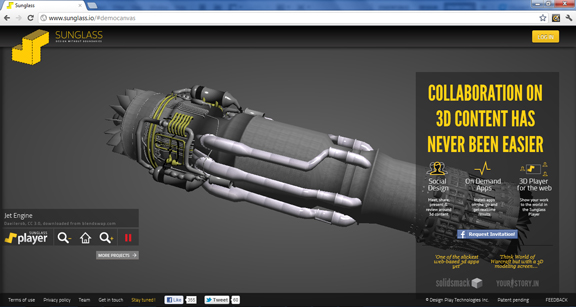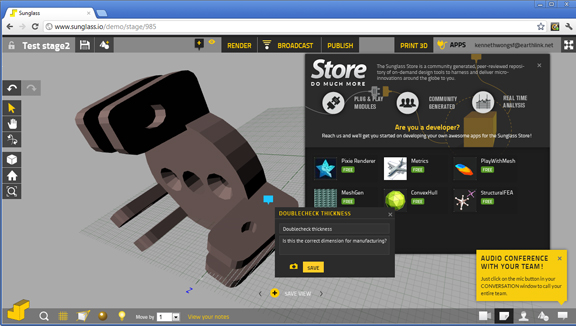Latest News
May 29, 2012
Would you and your team wear sunglasses to work together? The fashion statement is certainly not essential (unless you want to look like John Belushi and Dan Aykroyd in The Blues Brothers), but Sunglass, an online portal for browser-based collaboration, is worth a good look.
The idea for Sunglass was conceived a little over a year ago at MIT by Nitin Rao, a TED Fellow and a Sandbox Fellow, and Kaustuv DeBiswas, a TED Fellow and a member of the SmartGeometry Group. Rao received his MBA at MIT’s Sloan School of Management. DeBiswas has previously built CAD tools at Bentley Systems and taught computation at both Harvard and MIT. The young company currently operates out of its San Francisco and New Dehli locations.
Traditionally, collaboration involving CAD models called for a client-server approach—the design, or the 3D assembly model, lives on a central server, accessible from desktop and laptop clients. With Sunglass, the design is uploaded to the cloud, and the browser becomes your client.
Once you log into Sunglass (currently in Beta, so you’ll need approval from developers), you get access to virtual stages, or hubs for your projects. The stages function as virtual rooms where you and your team can present, share, and discuss ideas still in progress. They can be private or public. If you choose to open your ideas to public input (a process commonly referred to as “crowd sourcing”), you can choose to make the project public.
Sunglass platform supports a slew of common 3D file formats (IGES, STL, and STEP, for example) and some native CAD formats. You could have multiple people uploading different components of a scene. This feature allows you to collaborate on an assembly model, where several people may take ownership of different parts.
The current drag-and-drop positioning system in Sunglass works for casual placements, but a more refined snapping and positioning system is needed for assemblies that require more precise surface and axis relationships. Sunglass developers revealed they’re working on a system where each imported objects will be automatically anchored to a predefined position (think of it like reserving parking spots in 3D space, so each imported object can automatically park in a designated area). In theory, it sounds like a good solution for assembly placement where multiple parts are expected to come from different users.
The browser-based interface has audio chat function, camera views that can be saved, and a way to add notes (as if you are sticking Post-It notes onto a virtual cork board). There’s also a rendering option, which uses not your local CPUs but remote CPUs on Sunglass’s server. With this setup, you can continue to work on your desktop or laptop without experiencing a system slowdown while rendering is in progress.
Sunglass has a direct link to Ponoko, a 3D printing shop, so if you have an account there, you can instantly get quotes and produce your design as physical prototypes. The interface also gives you access to small collection of apps, expected to grow over time. (Current collection features airflow, meshing, and analysis apps, among others.) If you’d like to show your design to someone who doesn’t have a way to view 3D CAD files, you can publish it with the Sunglass player, viewable in a browser or online.
Current interface still has some kinks (perfectly understandable for a Beta version). For instance, the resize handles by default do not preserve the width-height-thickness ratios in your objects. In mechanical design, users generally prefer to maintain such ratios, as violating them could change the structural integrity of the design. And getting back to the project dashboard is not as straightforward as it should be.
All these minor issues notwithstanding, Sunglass gives us a glimpse into the future of browser-based collaboration, complete with options to integrate 3D printing, crowd sourcing, and on-demand apps.
For more, watch the video demo below:
Subscribe to our FREE magazine, FREE email newsletters or both!
Latest News
About the Author
Kenneth Wong is Digital Engineering’s resident blogger and senior editor. Email him at [email protected] or share your thoughts on this article at digitaleng.news/facebook.
Follow DE







